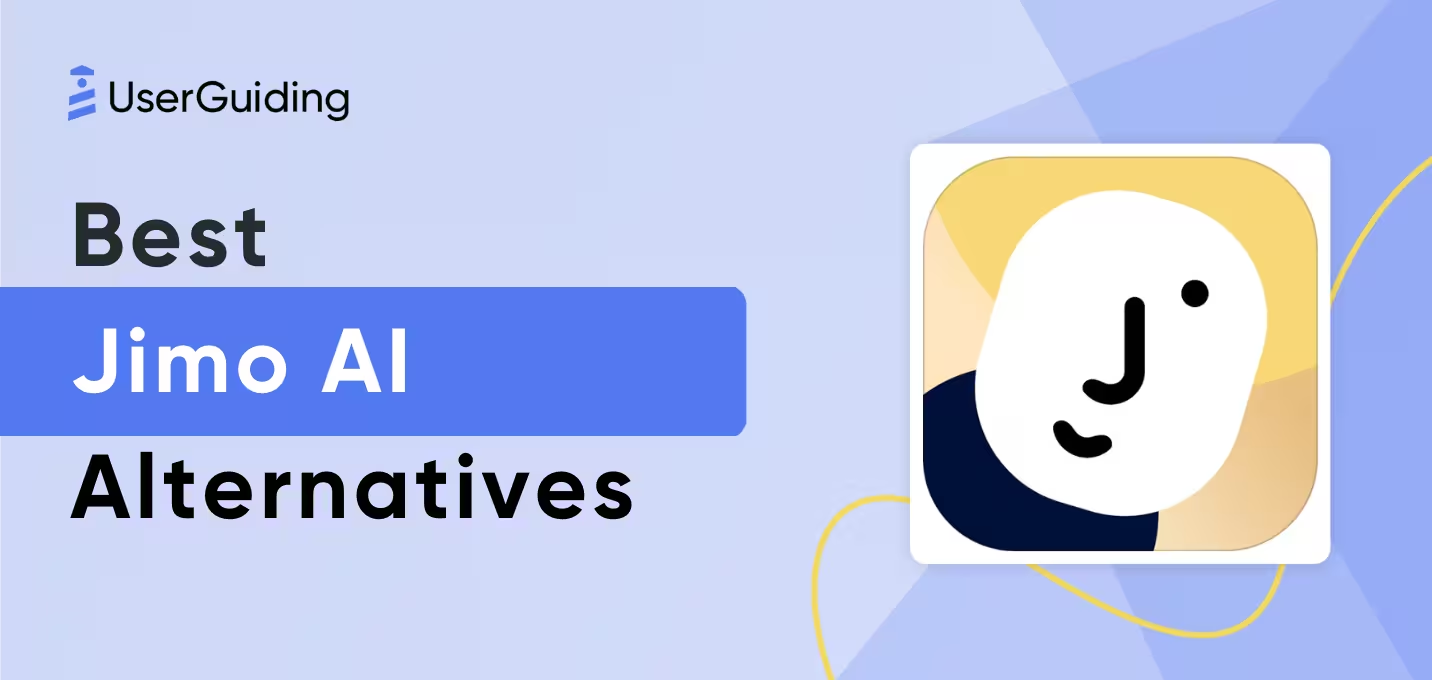

A two-digit starting price. Unlimited guides, tooltips, and hotspots. Sounds like a no-brainer, right?
Product Fruits lures you in with all the right words: “unlimited,” “affordable,” “no-code.”
But once you're in, the limitations start to show. Essential features like surveys, NPS, and AI tools? Only on higher plans. Customization? Minimal. Analytics?
Barebones.
In this article, you’ll:
- Uncover what you actually get (and don’t get) with each Product Fruits plan
- See what real users have to say about the experience
- Compare it with a smarter, more scalable alternative: UserGuiding
Let’s break it down.
TL;DR
- Product Fruits is a no-code onboarding tool offering core features like tours, tooltips, checklists, and in-app announcements. It’s best known for its budget-friendly entry point ($96/mo) and unlimited seats, domains, and core onboarding elements.
- However, key features like surveys, NPS, and AI tools are only available on higher plans, and there are no add-ons to unlock them on lower ones.
- Plans also aren’t designed around real customer needs or company maturity, which can lead to frustrating upgrade decisions.
- The platform’s customization, analytics, and UI feel outdated and limiting, making it difficult to scale or maintain brand consistency. Performance dashboards are basic, and users have reported technical issues with non-Chrome browsers.
- If you want a solution that grows with you, consider UserGuiding, a no-code, modern product adoption platform with deeper features, better customization, and transparent pricing for real use cases.
- Start your free trial and see for yourself.
What is Product Fruits?
Product Fruits is a user onboarding platform that allows you to create interactive in-app experiences to improve user retention, feature engagement, and customer satisfaction. Its main offerings include:
- Tours and guides
- Hints & tooltips
- Life Ring Button (resource center)
- Newsfeed (announcement center)
- In-app announcement modals
- Onboarding checklists
- NPS & surveys
- Feedback widget
- Knowledge base
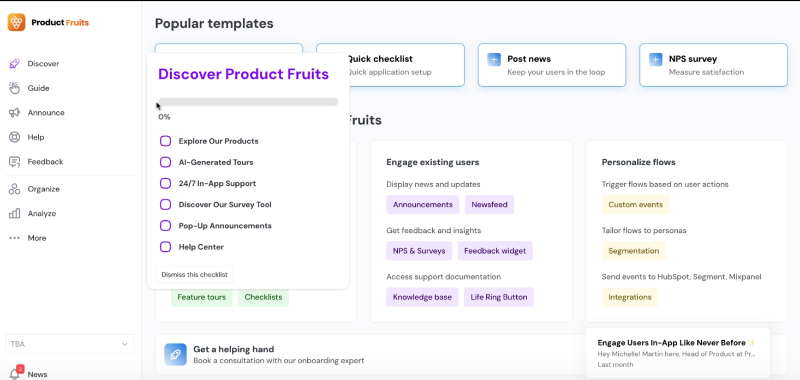
Product Fruits has recently introduced a new set of features powered by generative AI. The platform already offered an AI writer for creating, summarizing, and optimizing tour and tooltip microcopy, as well as generating tours with AI.
Now, it also supports the generation of announcements, banners, and newsfeed posts.
In addition, they’ve launched an AI chatbot called Copilot, which offers automated in-app support, along with an AI-powered search function that summarizes help center content to deliver concise, curated answers.
Here’s what the Product Fruits Copilot looks like:
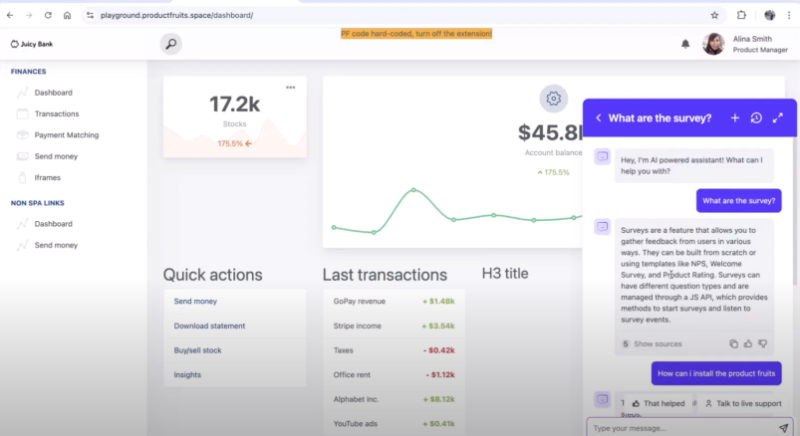
What is Product Fruits used for?
While it’s not a comprehensive all-in-one product adoption solution, Product Fruits provides a solid range of features that serve a variety of purposes.
Here are the platform’s core use cases and the tools it offers to support them:
- User Onboarding/Employee Training: Use tours, guides, and onboarding checklists to create interactive, engaging learning experiences for new users or team members. You can make your users’ first experience with your product smoother and decrease the initial learning curve a little bit.
- Contextual In-app Communication: Provide personalized, in-context guidance with hotspots and tooltips to help users navigate your product effectively. This will allow you to provide helpful tips and context that highlight your platform’s true value to users.
- Product Announcements: Communicate product updates and new feature releases through announcement modals and banners. By announcing your updates within your platform, you’ll ensure higher feature discovery.
- User Research: Collect feedback and measure customer satisfaction with surveys and the feedback widget to inform and optimize your product roadmap.
- Automated In-app Support: Copilot and the AI-powered search summary enable fast, automated support without the need for users to sift through long help articles.
- Support Document Centralization: Consolidate help content and documentation within your platform using the resource center and a standalone knowledge base. You can also link your knowledge base with your in-app support materials, which means you can manage your support materials from one platform.
- Feature Adoption Monitoring: Track usage and engagement with analytics dashboards and engagement reports to understand how features are being adopted. Though there’s no advanced event tracking or analytics, material engagement reporting can still provide you with valuable insights.
- UX Personalization: Customize the user experience with event-based triggers and user segmentation to create tailored, goal-oriented user flows. This way, you’ll be able to bring your users to their Aha! moment with your product way faster.
How much is Product Fruits?
Product Fruits offers a transparent pricing structure based on monthly active users (MAU).
There are three tiers: Starter, Pro and Enterprise. The base prices for the Starter and Pro plans are publicly listed on their pricing page, and an interactive MAU slider helps you estimate your total cost.
The seats and domains (or languages) do not affect your pricing with Product Fruits.
Now, let’s talk numbers 💰💰
The Starter plan starts from $96/mo for up to 1,500 MAU, when billed yearly. However, there’s also an option for monthly billing, in which case this price increases to $129/mo.
The Pro plan starts from $149/mo (billed yearly) for up to 1,500 MAU, and in the monthly billing scenario, it starts from $199/mo.
Product Fruits' pricing scales progressively with monthly active users (MAU).
For example, from 1,500 to 3,000 MAU, the Starter plan costs $149/month (billed yearly), and the Pro plan costs $224/month (billed yearly). When you move to the 3,000 to 5,000 MAU range, these prices increase to $186/month and $262/month, respectively –and both are billed yearly, again.
The Enterprise plan requires you to get a custom quote from their sales team.
Sure, those numbers might look sweet at first glance, but before you get too excited, there are a few quirks worth noting.
Here’s what Product Fruits customers are saying about the platform’s pricing plans and strategies on review sites like G2, Reddit, and Vendr.
- Startup-Friendly Pricing: Product Fruits sits on the lower end of the pricing spectrum compared to other user onboarding tools like Appcues or Userpilot (not even mentioning WalkMe or Pendo). It’s accessible for startups and small businesses looking to dip their toes into automated user onboarding experiences without breaking the bank.
It’s also a solid option if you don’t have a UX designer or dev team to build in-app experiences from scratch.
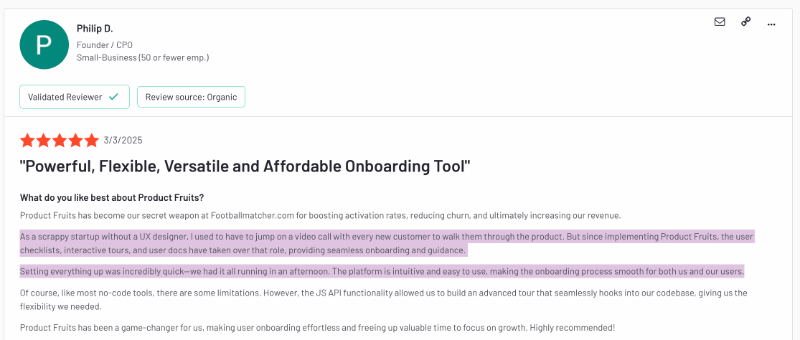
So yes, it’s a good (and affordable) place to start, but don’t expect it to carry you all the way. While the pricing technically scales with your growth, the product itself may not keep up with your evolving needs.
As a customer on Reddit put it, Product Fruits can start to feel a bit “meh” over time.

- Unbalanced Plans and Feature Set: While core features like tours, tooltips, and beacons are available across all plans (and are impressively unlimited), the way other important features are distributed across tiers can feel a bit off.
For instance, NPS and surveys aren’t included in the Starter plan. Some customers have voiced frustration over this, suggesting that at least a limited number of surveys should be available at the Starter level.
After all, upgrading to the Pro plan solely for access to surveys doesn’t make much sense for many teams.
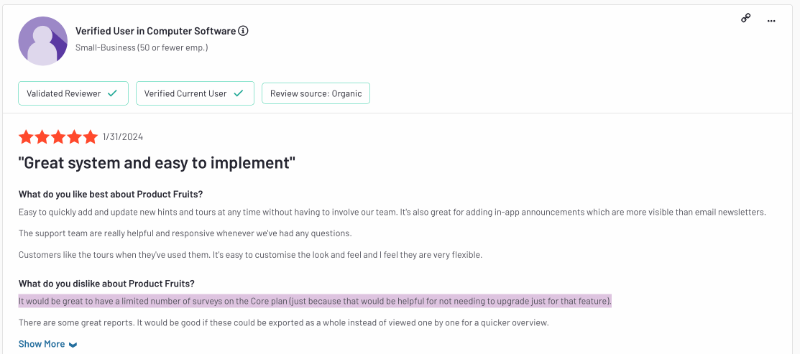
Another frequently mentioned concern is the lack of flexible add-on options for individual features.
For instance, some users have expressed the need for password-protected knowledge bases. However, upgrading to the Pro plan just to access this single feature may not be cost-effective for all teams.
Introducing a more modular add-on system for Starter users could offer a more practical and scalable solution, especially for those who only require specific functionalities without the additional quota or features they don’t need.
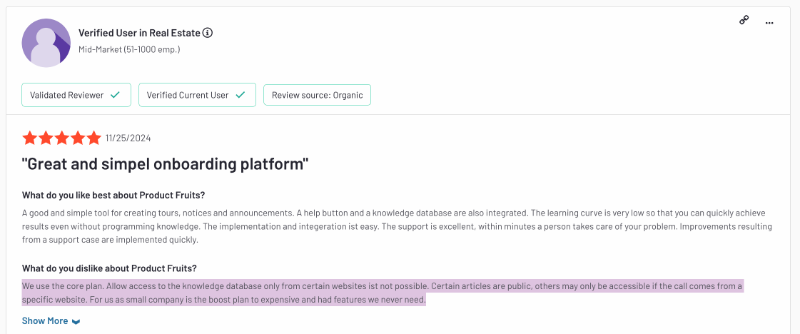
- Custom Integration Costs: If you’re on the Enterprise tier, you can request custom integrations from the Product Fruits team. However, these are priced separately, and according to former customers, they can significantly impact your total cost.
In terms of out-of-the-box options, Product Fruits supports integrations with popular platforms like HubSpot, Mixpanel, Google Analytics, Segment, and Typeform. While useful, the list isn’t particularly extensive, which may be limiting for teams with more specialized needs.
That said, if the current integration offerings fall short but you’re still interested in using Product Fruits, the Enterprise plan gives you the flexibility to request custom integrations.
Just be prepared for potential additional costs.
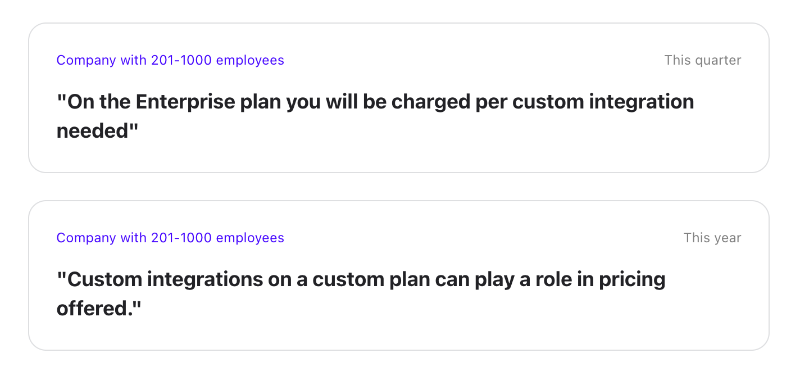
What are Product Fruits’ pricing tiers?
As we’ve mentioned, Product Fruits has 3 pricing tiers: Starter, Pro, and Enterprise.
Now that we’ve covered the pricing, how it scales, and what customers are saying about Product Fruits’ plans, let’s take a closer look at what each plan includes and how they differ from one another.
➡️ Starter Plan:
- Starting from: $96/mo (billed yearly)
- Features: Tours (unlimited), beacons (unlimited), tooltips (unlimited), checklists (3), announcement modals, newsfeed, life ring button, feedback widget, analytics, knowledge base (public)
- Capabilities: Dynamic personalization, user segmentation, custom attributes, custom CSS, localization (1)
- Customer Services: Live chat, email, video calls (limited)
- Integrations: Google Analytics, Heap, Sessionstack, ActiveCampaign, Customer.io, Slack, Intercom, Smartlook
- Ideal for: Startups and small teams that are beginning to implement in-app onboarding and communication, and need core functionality without complex customization or user research tools.
➡️ Pro Plan:
- Starting from: $149/mo (billed yearly)
- Features: Everything in Starter, + unlimited checklists, NPS & surveys, password-protected knowledge base, AI writer (100 queries/day)
- Capabilities: Everything in Starter, + custom events, JS triggers for tours, unlimited localization
- Customer Services: Everything in Starter
- Integrations: Everything in Starter, + Mixpanel, Segment, Hubspot, Typeform, Rest API, Zapier
- Ideal for: Growing product teams that need deeper user feedback, more advanced personalization, and broader integration options to support research and personalization needs.
➡️ Enterprise Plan:
- Starting from: Custom pricing.
- Features: Everything in Pro, + AI writer with custom limits
- Capabilities: Everything in Pro
- Customer Services: Everything in Pro, + a dedicated success manager
- Integrations: Everything in Pro, + custom integrations
- Ideal for: Larger organizations that require advanced support and custom integrations, along with enterprise-level security and account management capabilities.
As you can see, the Starter and Pro plans aren't clearly tailored to specific use cases like user research or in-app support. The distinction mainly lies in the available integrations and a few advanced capabilities, rather than a clear functional shift.
However, the absence of core features such as surveys in the Starter plan can be frustrating for users.
That’s why many customers remain on the Starter tier but express dissatisfaction with the missing features. For teams that only need one or two of the extras, like surveys or a password-protected knowledge base, it’s hard to justify upgrading to the Pro plan just for those additions.
What impacts Product Fruits’ pricing tiers?
Product Fruits has a very transparent pricing structure, with the starting prices of the plans visible on the pricing page, along with information about feature quotas (basically non-existent for some of the main features) and the monthly active users (MAU) slider.
They also allow you to highlight the differences between the plans in terms of features and offered capabilities, which makes it even easier to compare the plans.
However, in short, here’s what affects your contract prices with Product Fruits:
- Monthly Active Users (MAU)
- Chosen pricing tier (Core, Boost, Enterprise)
- Feature access needs (for surveys, AI writer, and password-protected KB)
- AI usage limits
- Integration requirements
- Dedicated success manager
- Security and account management needs
❌ And if you ask what does NOT affect the contract prices;
- Number of seats,
- Number of domains,
- Localization needs, and
- Customization or branding needs.
Is Product Fruits Worth the Cost? (Pros & Cons)
Pricing is always something buyers look at first, and it definitely matters.
But let’s be honest: it’s not the only thing that should drive your decision. If a product doesn’t actually solve your problems or help you reach your goals, does it really matter how affordable it is?
You still have to spend time setting it up, learning how to use it, and getting your team on board.
So, before you decide whether Product Fruits is worth the investment (not just in dollars, but in your time and energy,) here’s what their customers have to say about the platform 👇🏻
Pros of Product Fruits
To prove our good faith, we’ll start with the positive feedback they get.
- Easy to Use: Product Fruits is a no-code solution with a very low learning curve and a fast implementation process. Many of its customers state that they were able to start using the product quickly, even without a technical background or any prior experience with similar tools.
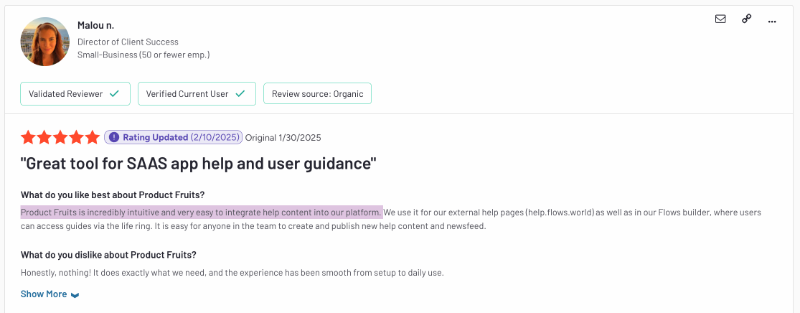
- WYSIWYG Previewing: Product Fruits’ feature builders allow you to preview content as you create and position it on your website. This means you can make updates, whether to the content or its placement, in real time, saving you the hassle of publishing first, checking it live, and then going back to make changes.
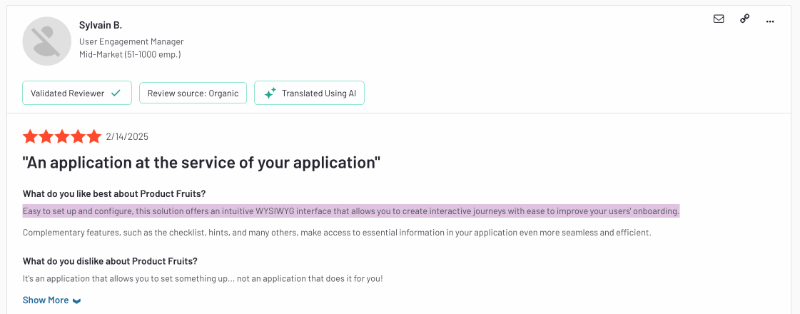
- Quick and Responsive: Product Fruits doesn’t have a native A/B testing feature. However, because the platform is easy to use and enables fast creation and publishing, several customers say they can still run tests or update materials in real time with ease.
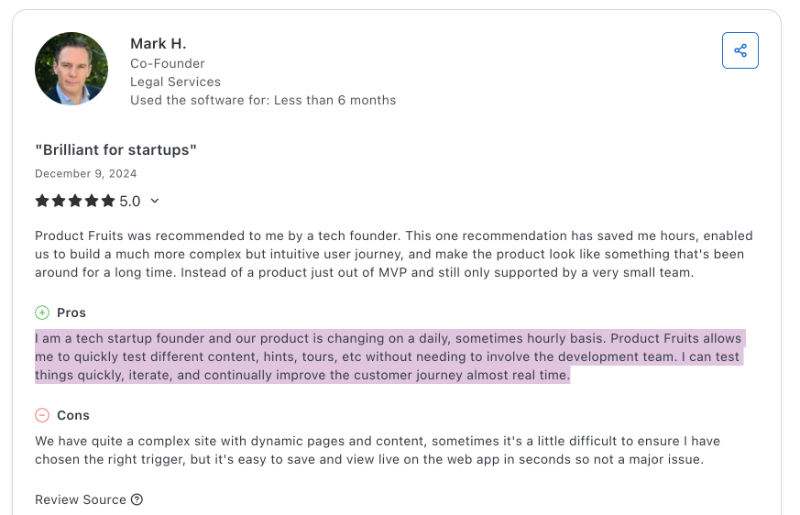
- Friendly Customer Service: Many of Product Fruits’ customers leave positive feedback about their customer-facing teams, including customer success and support. They describe the service as fast, effective, and highly responsive.
Customers also feel heard and valued, especially when it comes to feature requests and product updates.
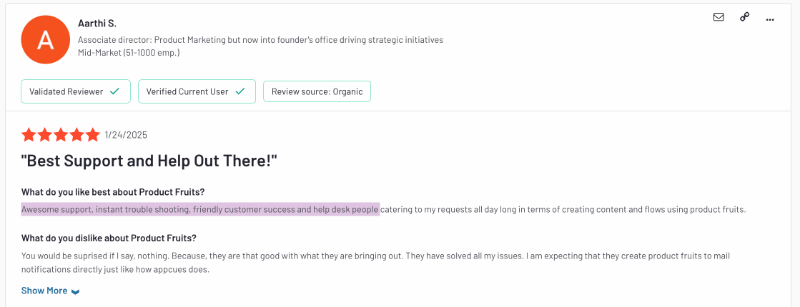
However, in contrast to the positive feedback on customer service, Product Fruits’ self-serve documentation has received criticism from users. Some customers find the help articles and product documentation insufficiently detailed, making it difficult to rely on them without live support.

Cons of Product Fruits
All that said, Product Fruits isn’t without its drawbacks…
- Lacking Use Cases/Feature Depth: Product Fruits is not an all-in-one solution for product adoption, user communication, or even feature engagement. Sure, it offers a solid range of features for these use cases, but it often needs to be supplemented with dedicated analytics, event tracking, and multi-channel communication tools.
Because, beside the lacking features, several customers complain about… 👇🏻
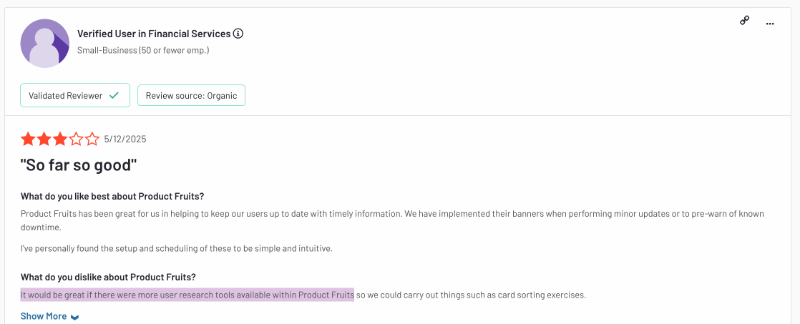
Product Fruits also lacks depth in the features it offers, or so some customers claim 👀

- Limited Customization Options: Product Fruits’ customization options beyond CSS are fairly limited, both when it comes to brand matching and also the templates for features like announcements or surveys.
Many customers express frustration, and sometimes even struggle, to make the materials they create with Product Fruits align with their platform’s design and overall aesthetics.
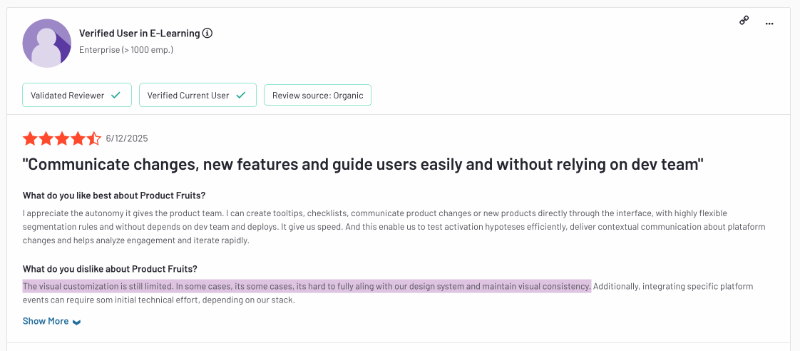
- Superficial Analytics Dashboards: Product Fruits offers engagement analytics, but they’re fairly basic. There’s no advanced event tracking, session recording, or heatmaps to help you truly understand user behavior and track user engagement patterns.
However, even for basic reporting, the analytics dashboards are quite superficial.
Several users mention that the dashboards don’t provide a comparative or analytical overview of content performance, you have to check each item individually. There’s no centralized view to highlight your best -or worst- performing content.
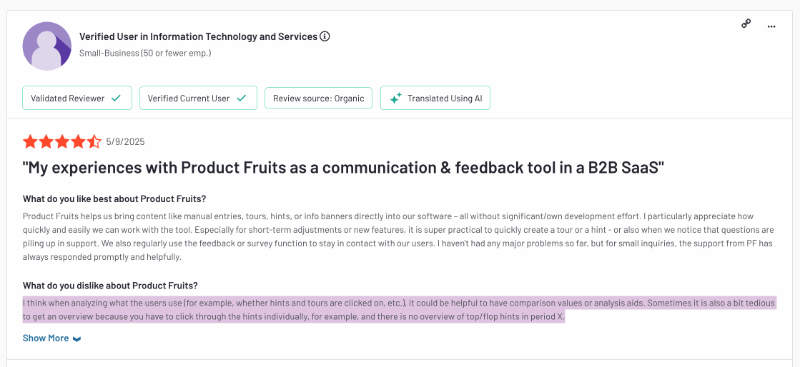
- Limited Browser Support: Several customers report issues when creating content in browsers other than Chrome, even in Chromium-based ones like Opera. There have also been cases where content failed to display properly for end users.
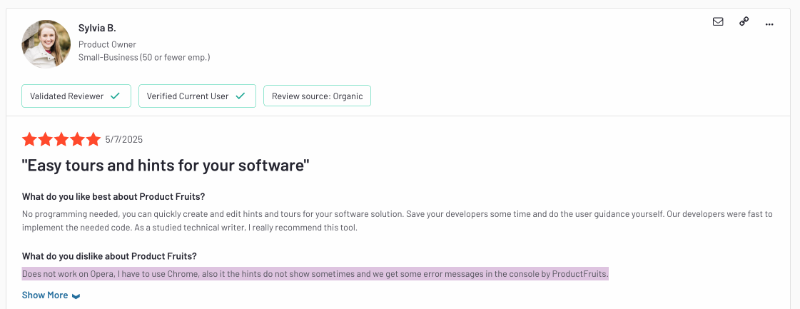
- Outdated Design: Closely related to the limited customization issue, the end materials created with Product Fruits can sometimes feel outdated.
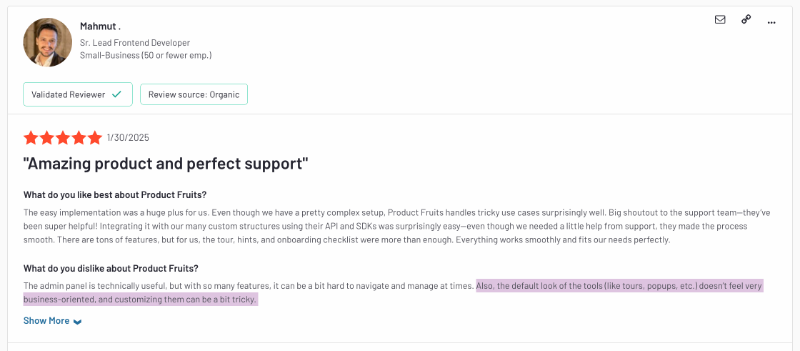
The platform’s own UI and layout also contribute to this impression and look old.
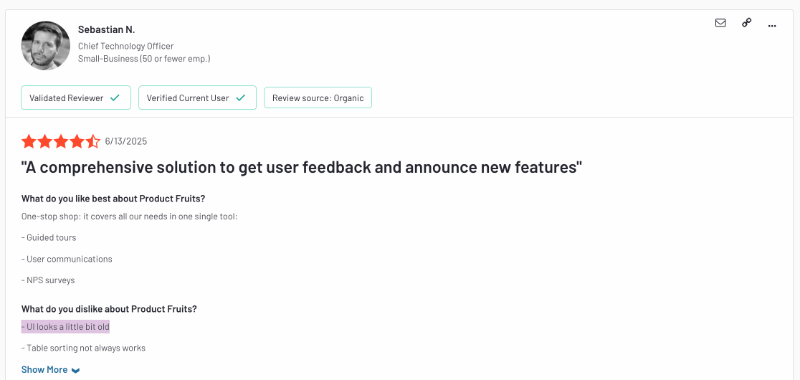
A better alternative to Product Fruits: UserGuiding
If these downsides outweigh the benefits Product Fruits offers, or even leave you second-guessing, then it might be time to consider a stronger alternative, like UserGuiding.
UserGuiding is a no-code, all-in-one product adoption platform that equips you with everything you need for user onboarding, communication, user engagement, and automated support. Here’s what you can expect in terms of features and capabilities:
- Product tours
- Onboarding checklists
- Hotspots and tooltips
- Announcement modals (banners, slideouts, pop-ups, etc.)
- NPS and custom in-app surveys
- AI assistant
- Resource center (in-app)
- Knowledge base (standalone)
- Product updates (standalone)
- Segmentation
- Analytics

As you can see, UserGuiding and Product Fruits share many similar features.
However, the actual value you get from those features can differ significantly. So, let’s compare both tools side by side, especially in the areas where Product Fruits tends to fall short 🔎
- Feature Depth and Use Cases: UserGuiding’s NPS and in-app survey capabilities are more advanced, varied, and customizable, as well as its announcement modals and templates.
The number of questions types you can ask with Product Fruits’ in-app surveys is less than what UserGuiding offers, which enables you to conduct actual user research and collect user insights and feedback for different motivations.
Here’s an example survey template from UserGuiding:

UserGuiding also offers more features for the same use cases that Product Fruits covers, such as product announcements and user communication.
For instance, with UserGuiding, you can create a standalone page for product updates and centralize your release notes. After all, no matter how eye-catching and engaging in-app modals are, some updates require longer explanations that only a release note can deliver.
On the flip side, minor UX/UI tweaks might not need flashy in-app announcements but can still be grouped into a single release note.
UserGuiding gives you the flexibility to choose how and where you announce updates: via release notes, in-app modals, or both.
Here’s an example of a product update note you can create with UserGuiding:
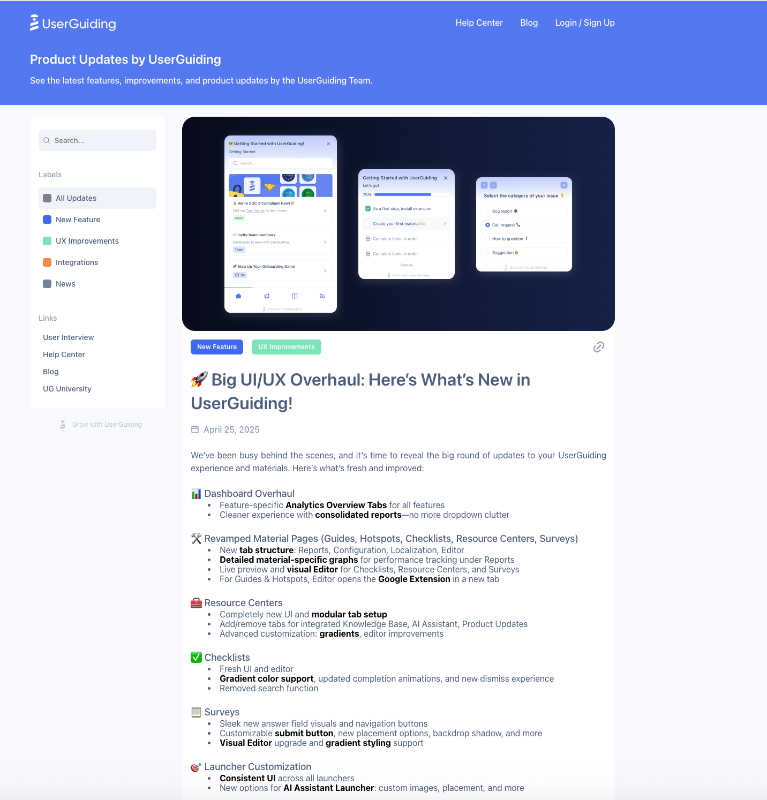
Plus, you can collect emoji reactions and anonymous feedback right under each product update and ensure two-way communication with your customers.
- Performance Dashboards & Reporting: Another area where UserGuiding stands out is its analytics dashboards. Now, to be fair, UserGuiding isn’t an analytics-first tool, so you shouldn’t compare it to full-fledged product analytics tools that offer advanced event tracking, heatmaps, session recordings, or deep behavior analytics.
But compared to Product Fruits, UserGuiding’s analytics and reporting capabilities are noticeably more detailed and insightful. The dashboards offer a more comparative and comprehensive view of your data, helping you understand what’s actually working.
Here’s a look at UserGuiding’s performance dashboard:
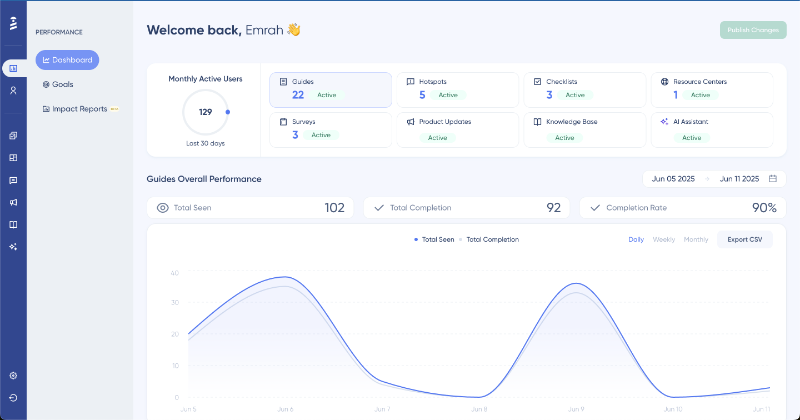

Unlike Product Fruits’ superficial reports, UserGuiding’s performance dashboards give you a clear, side-by-side view of how each guide performs, so you’re not forced to check them one by one or do manual comparisons.
You can quickly identify your top and lowest-performing guides at a glance.
Even better, the dashboards show you where users drop off or encounter friction in your guides with a step breakdown, too.
- Automated Self-Serve Support (both for you and your customers!): Both UserGuiding and Product Fruits allow you to create a knowledge base and an in-app resource center. These features look and function quite similarly. However, the difference shows when you need to rely on them.
Product Fruits’ self-serve help center has been criticized by some customers for not being detailed or helpful enough, which we’ve already covered under the platform’s cons.
UserGuiding, on the other hand, offers a much more comprehensive self-serve support system, including a help center, UG University, a resource center, and its AI agent, Dylan.
It’s well-maintained, regularly updated, and accessible for different learning styles and preferences.
Plus, while Product Fruits now offers an AI agent called Copilot as part of its new AI toolkit, its pricing, availability across plans, and the scope of its capabilities remain unclear.
In contrast, UserGuiding’s AI agent is available on all plans, including the freemium one, with 50 free resolutions included. It also comes with clear, accessible documentation to help you understand and compare its capabilities.
Here’s how it looks:

- Plans That Fit Customer Needs: Remember how Product Fruits’ customers often mention that the plan structure and feature availability don’t really make sense? Many feel forced to upgrade for features that should be basic.
That’s because Product Fruits’ pricing plans don’t seem to be designed with real customer needs or company characteristics in mind.
UserGuiding takes a different approach. It doesn’t gatekeep critical features based on arbitrary pricing tiers. Instead, it aligns its plans with your actual business needs like your user base size, team maturity, and product adoption goals.
Even the free plan, Support Essentials (more on that shortly), includes the core features you’d need for customer support use cases without forcing you to pay just to get started.
With UserGuiding, plan upgrades scale logically with your growth, rather than locking must-have tools behind enterprise-level pricing.
How much does UserGuiding cost?
UserGuiding offers three paid tiers (Starter, Growth, and Enterprise) and one free tier (Support Essentials). Before diving into the free tier and what it includes, let’s first explore the paid plans, since they support a broader range of use cases and needs.
UserGuiding follows a transparent, MAU-based pricing model.
- The Starter plan starts at $174/month (billed yearly) for up to 2,000 MAU.
- The Growth plan starts at $349/month (billed yearly), also for up to 2,000 MAU.
If you prefer monthly billing, the starting prices shift to $249/month for Starter and $499/month for Growth.
Yes, the starting price of UserGuiding is higher than Product Fruits’ Starter plan.
But when comparing the available features and capabilities, UserGuiding’s Starter plan clearly stands out.
With it, you get access to all the essential product adoption features: Guides, tooltips, hotspots, checklists, the AI agent, resource centers, NPS, custom in-app surveys, announcement modals, product updates, and a knowledge base, plus solid reporting and product analytics tools.
Need even more?
The Growth plan adds advanced features like A/B testing, goal tracking, and custom click action tracking, along with expanded feature limits, more integrations, and account management capabilities.
🔙 Now, back to the free plan.
UserGuiding’s Support Essentials is a carefully curated selection of UserGuiding’s features, capabilities, and integrations specifically tailored for customer support and service teams.
You get an in-app resource center, a standalone knowledge base, a product updates page, and an AI assistant with 50 free resolutions, along with basic engagement analytics tools and daily/weekly reporting capabilities.
Additionally, you'll have access to integrations with platforms like Google Analytics, existing knowledge base tools, and live chat software.
Access to onboarding resources and customer support (platform tutorials, help center, UG University, email support, and troubleshooters) is also included to help you get started and succeed.
So as you can see, Support Essentials isn’t one of those pretentious free plans that look like a plan but actually are just clickbait where the company resents you for choosing it and offers zero support or service (no, definitely not side-eyeing Pendo Free right now!).
Final Thoughts: Choosing the Right Plan or Alternative
Have you made your decision yet? If not, let’s simplify everything we’ve covered so far.
You have two roads ahead of you:
One is Product Fruits with a relatively budget-friendly starting price. But be warned: that road might not take you all the way to your destination. You could end up needing to switch tools mid-journey, which means more money, more time, and definitely more frustration.
The other road is an alternative solution, like UserGuiding, which is still more cost-effective than many other options out there, though yes, it costs a little more than Product Fruits.
But that extra cost comes with serious value: more reliability, better scalability, and a more comprehensive feature set that can actually support your long-term product adoption goals.
You should choose Product Fruits if:
- Budget limitations matter more to you than feature limitations.
But even then, depending on your use case, Product Fruits’ “budget-friendly” price might not be enough, and UserGuiding’s free plan could actually serve you better. Just saying.
That’s pretty much it.
Because when you line things up side by side, Product Fruits’ only real advantage is its lower starting price. Feature for feature, capability for capability, UserGuiding either matches or outperforms it. Especially when it comes to customization, modern design, and feature depth.
So, go with UserGuiding if:
- You want a true all-in-one product adoption platform with deeper functionality.
- You want more room for customization and branding, with a fresh, modern look (without CSS wizardry.)
- You want product analytics that actually make sense for comparing and improving your content (still no dev team needed).
Frequently Asked Questions
How much does Product Fruits cost for mid-sized SaaS companies in 2025?
Product Fruits’ Starter plan starts at $96/month when billed annually, but it’s mostly for early-stage startups with very basic needs. For mid-sized SaaS companies, the more realistic option is the Pro plan, which starts at $149/month for 1,500 MAU (yearly billing). If your active user base is between 5,000 and 10,000 MAU, that plan will cost you $374/month. These prices increase further with monthly billing. While the base price may seem affordable, the total cost grows quickly depending on your team size and must-have features like surveys or product analytics.
How much are Product Fruits’ pricing tiers and features for user onboarding, tooltips, and surveys?
Product Fruits offers three pricing tiers: Starter, Pro, and Enterprise. Starter includes unlimited tooltips, guides, and beacons, along with up to three checklists. However, surveys, NPS, and the AI writing assistant are not part of the Starter plan. To access these onboarding and feedback features, you’ll need at least the Pro plan, which starts at $149/month for up to 1,500 MAU. This makes the Pro tier the more complete option for teams aiming to manage the full user onboarding flow with in-app communication and user feedback.
What is included in each Product Fruits plan: Essentials, Business, and Enterprise?
Product Fruits doesn’t label its plans as Essentials or Business but rather Starter, Pro, and Enterprise. Starter includes unlimited guides, tooltips, and beacons, with three checklists. Pro adds surveys, NPS, AI Copilot, and unlimited checklists. The Enterprise plan unlocks advanced features like SSO, audit logs, permission control, as well as a dedicated customer success manager and option for custom integrations. The custom integrations are priced individually, though.
How do Product Fruits, Appcues, and Userpilot’s prices compare for onboarding functionality?
Among the three, Product Fruits has the lowest starting price. Its Starter plan begins at $96/month for 1,500 MAU when billed annually. In contrast, Appcues starts at $300/month for 1,000 MAU, and Userpilot begins at $299/month for 2,000 MAU. However, Product Fruits’ lower cost comes with limitations, especially around advanced onboarding and engagement features. If you're only looking for basic tooltips and guides, it’s a cheaper fit. But for more complete onboarding functionality, the Product Fruits alternatives may offer stronger capabilities even at a higher cost.
Does Product Fruits offer usage-based pricing or fixed seat licenses?
Product Fruits follows monthly active users (MAU)-based pricing, meaning your costs scale with your monthly active user count. It doesn’t charge by seat or domain; every plan comes with unlimited seats and domains, which is helpful for growing teams. However, while core onboarding features like guides and tooltips are always unlimited, access to checklists, surveys, NPS, and AI features is plan-dependent. So while your team size doesn’t affect your cost directly, your actual usage and feature needs certainly will.

















.svg)
.svg)
.svg)
.svg)
.svg)

.svg)
.svg)












.svg)
.svg)





.png)
